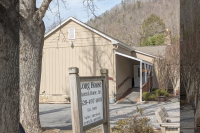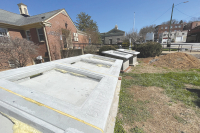Cost-benefit of school safety weighs on Haywood
Law enforcement officials in Haywood County are stepping up to keep a watchful eye on schools as leaders plot their next steps toward increasing safety.
Parents have probably already noticed one simple and cost-free solution to better school security: deputies and police officers have started parking their patrol cars at one of Haywood County’s 16 schools whenever they need to take care of administrative tasks such as filling out reports or doing paperwork.
A parent suggested the idea of a “park-and-watch” protocal for patrol officers to sit in school parking lots during downtime on their shifts at a school board meeting in January shortly after school safety came into national focus following the Sandy Hook shooting.
Superintendent Anne Garrett took the idea to law enforcement agencies, and it was well-received. The tool has been implemented in some other communities as well.
“We also invited them to come and eat breakfast and lunch,” Garrett said. It would be “on the house” anytime officers join kids in the cafeteria, she said.
Related Items
The goal is to generate a greater police presence at the schools while county and school leaders debate whether to hire enough school resource officers to man each of the 16 public schools. If money were no option, the decision would be simple.
“We would definitely like to have one in every school,” Garrett said.
But it would come at a high cost to the county. The county currently pays $288,955 for five school resources officers who work at the middle and high schools.
There are no resources officers at any of the county’s 11 elementary schools. It would cost $770,666 the to 11 officers, which includes vehicles and other related expenses the first year.
“That is a pretty big number,” said Chuck Francis, chairman of the school board.
It would ultimately be up to the county commissioners whether to fund the officers, but the school board first must decide whether to even request them.
But employing more school resource officers is not the only option. The county could instead spend money during a period of years on safety improvements such as upgrading security cameras or possibly installing a button that would simultaneously lock every door when a school goes into lockdown.
“The more barriers we can create the better off we will be,” said Tracy Hargrove, maintenance director for Haywood County schools.
Hargrove is researching a variety of school safety measures, including the possibility of providing school kids with ID cards or another item to swipe into their school.
The idea is particularly appealing for the high schools, where students are constantly entering and exiting different buildings for classes, and Waynesville Middle School, which has more doors than could be adequately covered.
The Haywood County School Board has not officially backed any course of action but has met regularly with others to talk about school safety.
“Everything is on the table as far I am concerned,” Francis said.
The school district has already implemented some changes. Parents are no longer allowed to walk their kids through the halls. Only school employees can pull a student out of a class to leave early. And teachers are now trained to ask any stranger who they are and what they are doing at the school.
Francis has received calls from parents complaining about the rules inhibiting them from moving freely around the school as they used to, but he said it’s worth it as long as the kids remain safe.
“I think I would be willing to take those irate phone calls,” Francis said.
As a pilot program, the county installed a video entry system in one of its elementary schools. The school’s doors remain locked to the outside all day. Receptionists act as gatekeepers. They can look at a video of someone outside the door wanting to enter the school before deciding whether to buzz them in.
It’s a departure from how the schools were designed.
“We built these schools to be open and inviting. We didn’t build them for intruders,” Garrett said.
But past tragedies have forced school leaders to be more cautious and protective of students in their care.
In Jackson County, the sheriff and school leaders asked the county earlier this month for $200,000 to hire officers to be stationed in its four elementary schools, plus $150,000 in start-up costs for equipment. But commissioners were not ready to commit, and some expressed reservations that it would not be a wise use of money or accomplish the intended goal.
A request for more resource officers is pending from the Macon County school district.
In Swain County, the board of commissioners did not hesitate to hire three new officers in January, promptly putting in school resource officers at its elementary and middle schools following Sandy Hook. And at a recent meeting, Swain commissioners and school board members expressed satisfaction with the choice.
“I think you heard a collective sigh of relief,” said Mellie Burns, a Swain County school board member.
Haywood County school leaders plan to wait until spring budget planning gets in full swing to officially lobby for funding for school safety measures. But in the meantime, local law enforcement will continue to keep a close eye on the schools.
Newly appointed Sheriff Greg Christopher is in the process of assigning deputies to different areas of the county, which they will be responsible for while on-duty.
“As that deputy takes ownership of their area, they will take ownership of that school,” Christopher said.
Waynesville police officers have also made a more concerted effort to cruise by schools in the town limits as of late. However for years now, the police department has sent one patrol car to each school for morning drop-off and, if it can, for afternoon pickup.
“It makes me feel better when I drop kids off at the school,” said Waynesville Police Chief Bill Hollingsed.
In the event of an emergency, officers also have access to school layouts and emergency response plans so first responders know what to expect when they arrive.













